Choosing the Right Baby Bottle: Why It Matters More Than You Think
Selecting the best baby bottle is more than a matter of convenience—it directly impacts your baby’s comfort, digestion, and feeding habits. The right bottle can ease the transition between breastfeeding and bottle-feeding, reduce gas and colic, and ensure proper nutrition. In 2025, with more advanced materials, venting systems, and nipple shapes, it’s easier than ever to find the perfect fit for your newborn or infant.
This guide explores the most important factors to consider and reviews the five best-selling baby bottles on Amazon. Whether you are looking for anti-colic solutions, bottles for breastfed babies, or simply easy-to-clean and leak-proof options, this article is your comprehensive resource.
What to Look for in a Baby Bottle
When shopping for baby bottles, several features stand out as essential:
- Anti-Colic Venting Systems: These reduce the amount of air your baby swallows, helping to minimize gas and colic.
- Nipple Types and Flow Levels: Choose between slow, medium, or fast flow depending on your baby’s age and feeding needs.
- Material: Bottles are commonly made of BPA-free plastic or heat-resistant glass. Each has benefits in durability and safety.
- Ease of Cleaning: Wide-neck designs simplify cleaning and filling, while dishwasher-safe materials save time.
- Size and Shape: Consider ergonomic shapes for better grip and sizes ranging from 4 to 9 ounces depending on age.
Understanding these basics helps you select a bottle that fits both your baby’s preferences and your lifestyle.
Top 5 Best Baby Bottles in 2025: Expert Comparison
Here are the top five best-selling baby bottles on Amazon right now, compared based on performance, features, and user reviews.
1. Dr. Brown’s Natural Flow Anti-Colic Options+ Narrow Baby Bottle – 8 oz (4 Pack)
Dr. Brown’s continues to be a parent favorite thanks to its advanced anti-colic system. The patented internal vent system is designed to prevent air bubbles and vacuum pressure, which helps reduce feeding issues like gas, spit-up, and burping. The narrow neck makes it easy for small hands to grip, while the Level 1 slow flow nipples are ideal for newborns.
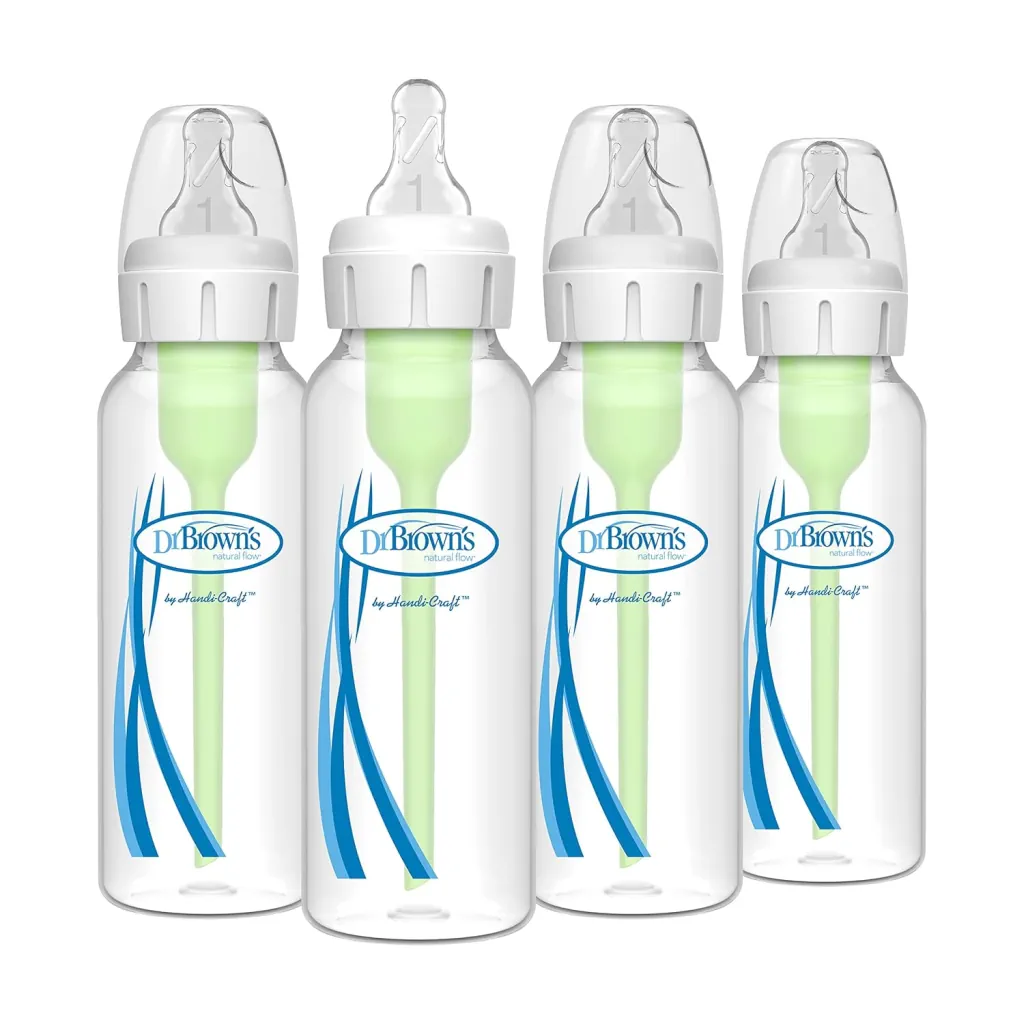
These bottles are BPA-free, dishwasher safe, and clinically proven to preserve milk nutrients. The 8 oz size suits growing babies, and the set of four is great for parents who want consistency. Though slightly more complex to clean due to the extra parts, many parents find the benefits outweigh the effort. Overall, this is an excellent option for babies experiencing colic or digestion troubles.
See price on Amazon
2. [BabyPure] Anti-Colic Baby Bottles with Vent System – 5.4 oz (2 Pack)
The BabyPure bottles feature a modern, wide-neck design that makes cleaning and pouring formula or breast milk incredibly easy. With a built-in vent system to reduce colic and BPA-free materials, they cater to both breastfed and formula-fed babies.
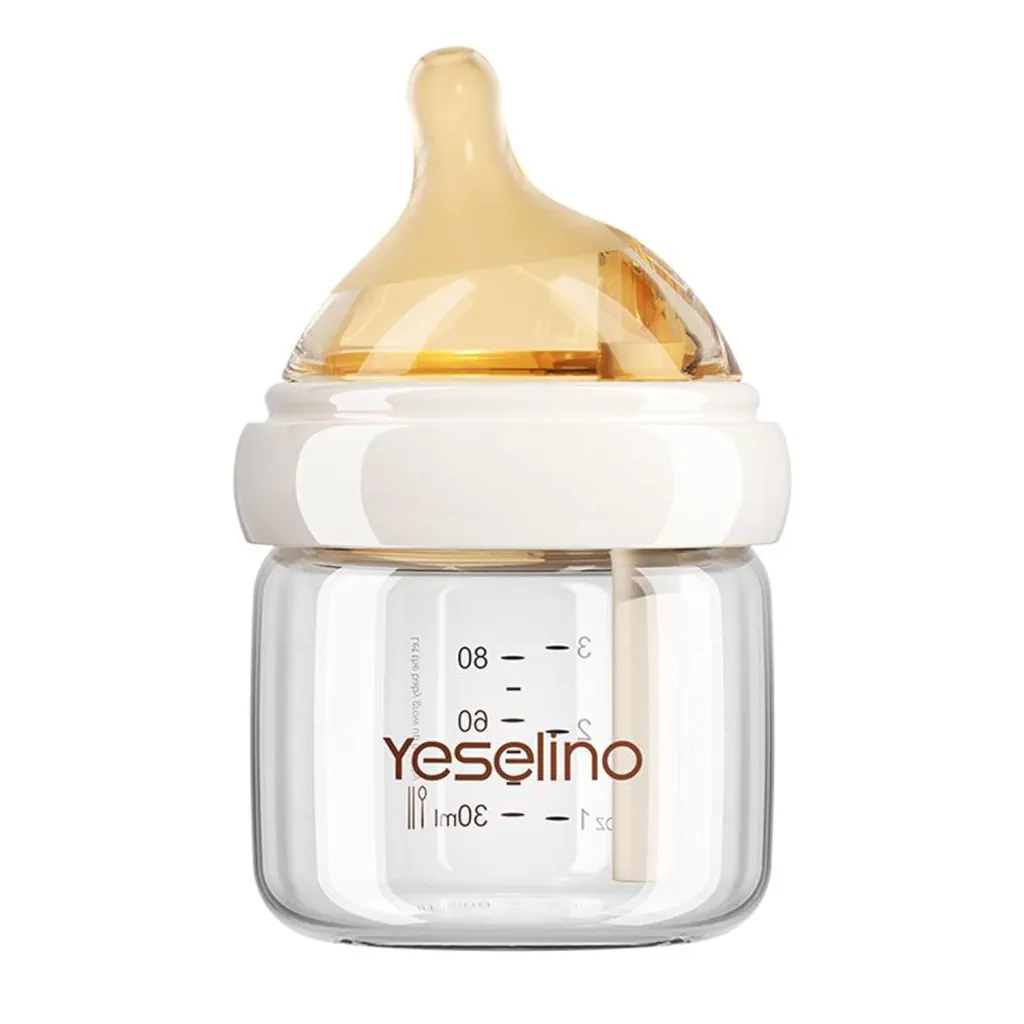
Parents appreciate the leak-proof seal and the soft, breast-like nipple that promotes natural latching. Each bottle holds 5.4 oz, making them suitable for younger infants. The bottles are also dishwasher safe and designed with a non-slip ergonomic shape for easier handling. The value-for-money pricing and straightforward design make these bottles a strong contender for parents seeking a budget-friendly but high-quality choice.
See price on Amazon
3. Philips Avent Natural Glass Baby Bottles with Natural Response Nipples – 4 oz (4 Pack)
These glass bottles offer a premium option for parents who prefer to avoid plastic. Made from durable, heat-resistant borosilicate glass, they are free from harmful chemicals and easy to sterilize. The Natural Response nipples are designed to mimic the breast, which helps babies feed at their own pace—ideal for breastfed infants.
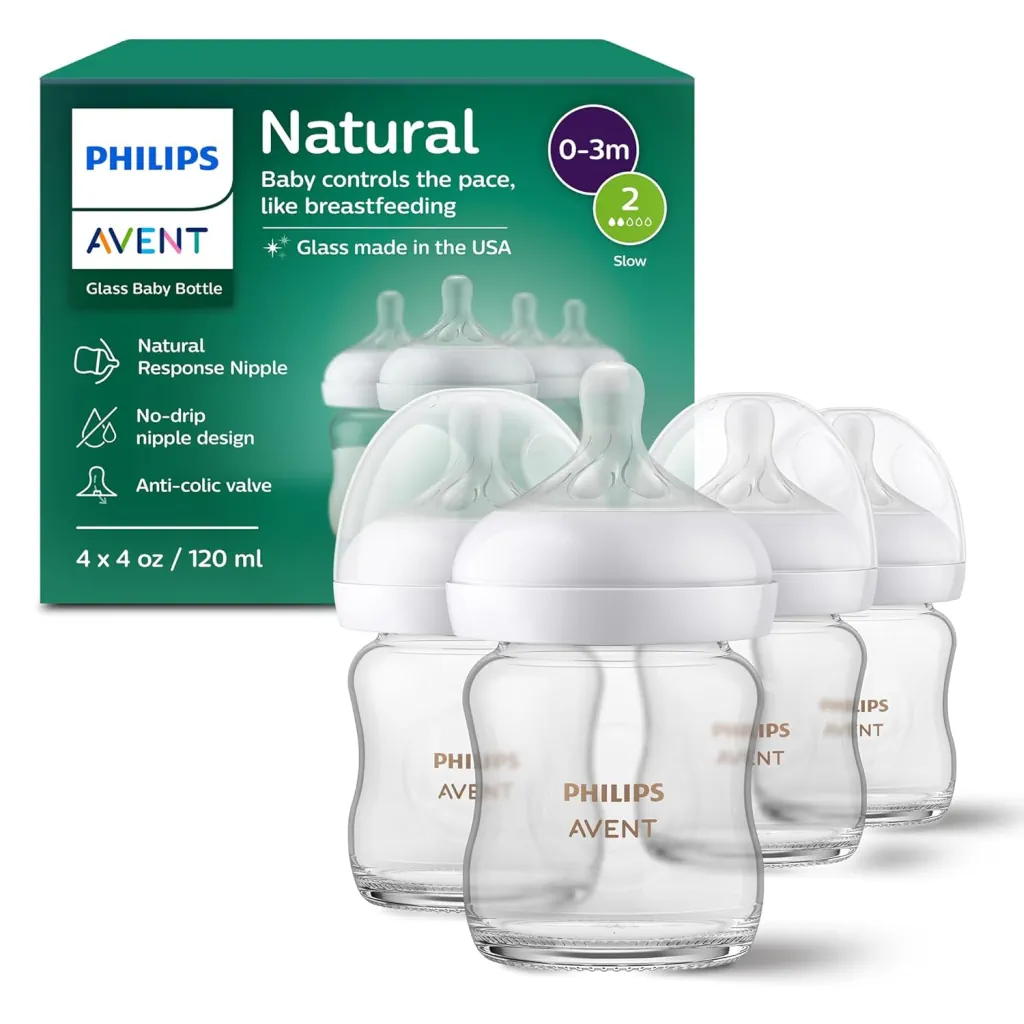
With a slow flow (Flow 2) nipple, these bottles are perfect for newborns. The 4 oz size works well for early months, and the four-pack offers convenience for busy feeding schedules. While slightly heavier than plastic, the high-quality construction and safety make them a top pick among health-conscious parents.
See price on Amazon
4. Philips Avent Natural Baby Bottles with Natural Response Nipples – 9 oz (4 Pack)
This version of Philips Avent’s Natural bottles is made from BPA-free plastic and includes medium flow (Flow 3) nipples, making it a better choice for babies over 3 months. The Natural Response design helps babies control milk flow similar to breastfeeding, which makes the transition smoother for both parents and babies.
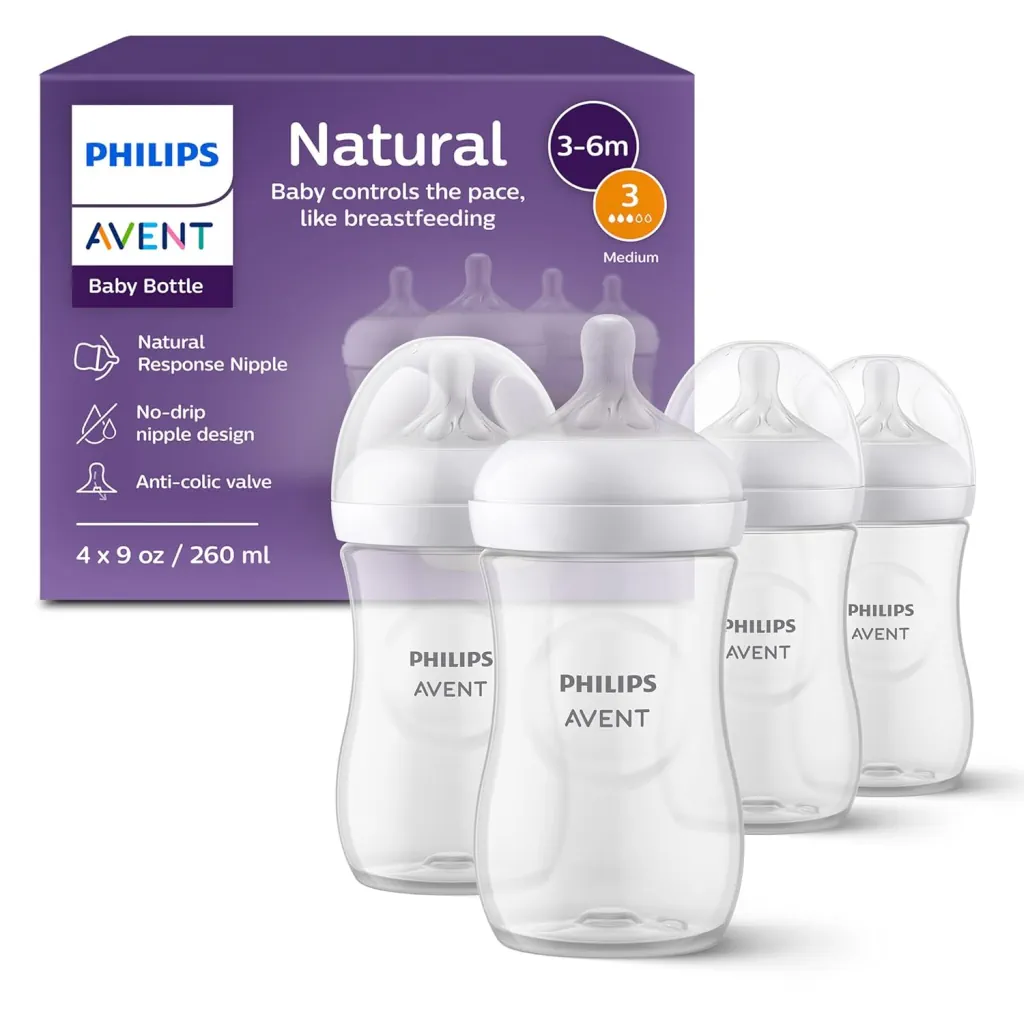
With a 9 oz capacity, these bottles are suitable for longer feeding sessions or older babies with bigger appetites. Parents appreciate the wide neck for easier cleaning, the leak-resistant design, and the compatibility with Avent accessories like warmers and sterilizers. It’s a great option for mixed feeding routines.
See price on Amazon
5. Philips Avent Anti-Colic Bottle with AirFree Vent – 9 oz (4 Pack)
Designed specifically to address colic and gas issues, this bottle includes the innovative AirFree vent, which keeps the nipple full of milk rather than air. This design helps reduce issues like reflux and gas, especially in young infants.
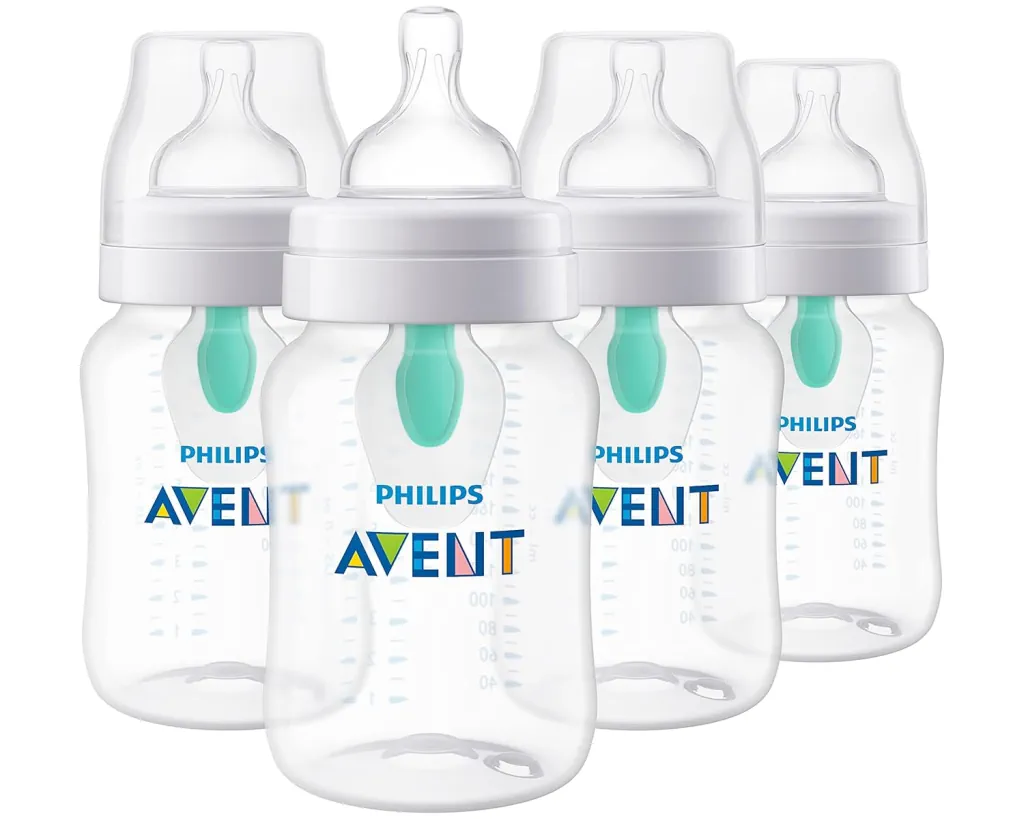
The bottle comes with Flow 2 nipples, suitable for babies 1 month and older. It’s made from clear, BPA-free plastic and holds 9 oz of milk or formula. Parents love the ergonomic shape and the ease of assembly. It’s also compatible with other Avent parts. For parents prioritizing anti-colic features in a familiar, trusted brand, this bottle stands out.
See price on Amazon
Glass vs. Plastic Baby Bottles: Which One Should You Choose?
Choosing between glass and plastic bottles depends on your preferences, lifestyle, and safety concerns.
Glass bottles are chemical-free, easy to sterilize, and long-lasting. They’re ideal for parents who want a pure feeding experience without the risk of plastic leaching. However, they are heavier and can break more easily.
Plastic bottles, especially BPA-free ones, are lightweight and less likely to break, making them great for travel or on-the-go feeding. They are generally more affordable and come in a wider variety of shapes and sizes. However, plastic can degrade over time and may require more frequent replacement.
Some parents opt to use both, depending on the situation: glass at home and plastic when traveling. Ultimately, both options are safe if used and cleaned properly.
Tips for Introducing Bottles to Breastfed Babies
Introducing a bottle to a breastfed baby can be a challenge, especially in the first few weeks. Timing, technique, and bottle choice all matter.
- Wait 3 to 4 weeks before introducing a bottle if breastfeeding is well-established.
- Use nipples that mimic the breast in flow and shape to prevent nipple confusion.
- Offer the bottle when the baby is calm, not overly hungry or upset.
- Let another caregiver offer the bottle, as babies often refuse bottles from breastfeeding mothers.
Bottles like Dr. Brown’s and Philips Avent Natural are often recommended for transitioning because of their natural-shaped nipples and flow control.
Cleaning and Sterilizing Baby Bottles Safely
Proper cleaning is crucial to prevent bacteria buildup. Here are best practices:
- Before first use, sterilize all parts by boiling them for 5 minutes or using a steam sterilizer.
- After each feeding, disassemble bottles and wash with warm soapy water or in a dishwasher.
- Use a dedicated bottle brush to clean hard-to-reach areas.
- Air-dry all parts on a clean drying rack, not with kitchen towels which may carry germs.
Regularly check nipples and bottle components for signs of wear, discoloration, or damage and replace as needed. Most manufacturers recommend replacing nipples every 2–3 months.
FAQs About Baby Bottles in 2025
Which baby bottle is best for colic?
Dr. Brown’s Natural Flow and Philips Avent Anti-Colic with AirFree Vent are both highly rated for reducing colic symptoms. They include advanced venting systems to minimize swallowed air.
Are glass baby bottles better than plastic ones?
Glass bottles are more durable and chemical-free, making them ideal for parents concerned about plastic exposure. However, plastic bottles are lighter and more convenient for travel.
What’s the right flow nipple for newborns?
Newborns typically need slow-flow nipples (Level 1 or Flow 2), which allow them to feed without being overwhelmed. Always observe your baby’s feeding behavior and adjust accordingly.
How many baby bottles do I need for a newborn?
Most parents find 6 to 8 bottles sufficient, especially when using bottles exclusively or pumping. Having extras helps reduce the frequency of cleaning.
Can I use different brands of nipples with bottles?
It’s best to use the same brand of nipples and bottles, as not all parts are universally compatible. Mixing brands may lead to leaks or improper flow.
Conclusion: Choosing the Best Baby Bottle for Your Child’s Needs
Selecting the best baby bottle depends on your baby’s age, feeding method, and individual needs. Dr. Brown’s offers excellent anti-colic benefits for newborns, while BabyPure provides a balanced and affordable choice. Philips Avent’s wide range—including glass, anti-colic, and natural response nipples—makes them a versatile and trusted brand.
Whether you’re breastfeeding, formula feeding, or doing both, the right bottle can make feeding smoother and more comfortable for everyone. Focus on safety, ease of use, and how well your baby accepts the bottle, and you’ll find a perfect match.
Read also the article: How to Properly Bathe a Baby: Essential Safety and Care Tips for New Parents and Best Baby Strollers for Newborns in 2025: Safe, Stylish & Parent-Approved Picks and Best Diapers for Newborns in 2025 and Breastfeeding in 2025: Tips for a Successful Start
This article contains affiliate links. If you make a purchase through them, we may earn a small commission at no additional cost to you.
Note: This article is for informational purposes only and is not a substitute for professional advice. While every effort has been made to ensure that the content is accurate and useful, the portal does not guarantee the complete accuracy of all information. For specific cases and personalized solutions, we recommend consulting with a licensed professional in the relevant field.
